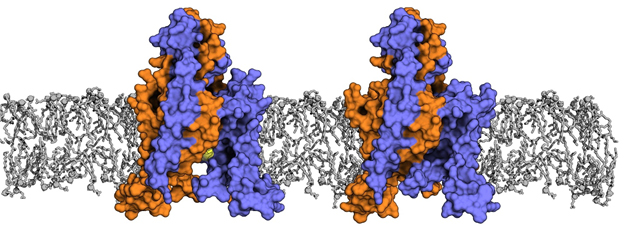MCB TRANSCRIPT

Mechanosensation: How Ion Channels Turn Force Into Feeling
What do touch, hearing, balance and pain have in common? They all rely on ion channels that translate mechanical force into electrical signals. But biologists don't know exactly how this works. "How do we feel when something touches our skin, and hear when sound vibrates our eardrums?" asks MCB Assistant Professor Stephen Brohawn. "It's a really interesting question: how do you build a force-sensing machine in a membrane?"

Brohawn's interest in interactions between membranes and membrane proteins stems from his graduate work, when he studied proteins that stabilize and scaffold the nuclear pore complex — which regulates what gets into and out of the nucleus — in the nuclear envelope. Then, as a postdoc, he figured out how force opens a neuronal potassium channel called TRAAK, which generates an electrical impulse when the cell membrane is stretched. "We only knew how mechanosensitive ion channels work in bacteria," he says. "This was the first time we understood how one works in animals."
Using X-ray crystallography, Brohawn compared the structure of TRAAK when it was open and closed. "It works in a strange way," he says, explaining that bacterial versions dilate and restrict like a camera lens. In contrast, when TRAAK is closed, it has a hole in its side that allows a membrane lipid to enter the channel and block ions. When the membrane stretches, however, TRAAK changes its shape and seals that hole. This keeps the lipid from plugging the channel, allowing ions to pass through.
Now Brohawn wants to understand how other mechanosensitive ion channels work. How do they open and close? Is force transmitted directly from the membrane, as it is for TRAAK, or indirectly via intermediary elements? And how do membrane properties affect mechanosensitivity?
Another big question is how mechanosensitive ion channels work in concert to give a neuron its electrical properties. In contrast to the current approach of using mutations that knock out function, Brohawn plans to develop tools including antibodies that will fine-tune the activity of specific channels, revealing how they shape the mechanosensory response of individual neurons.
His work could lead to better treatments for disorders and diseases linked to mechanosensitive ion channels. These channels are targeted by drugs (anesthetics, antidepressants and antipsychotics) and antibodies may modulate channel activity more selectively.
"It's a wide-open area of biology," Brohawn says. "There are lots of discoveries to be made."

right: stretching the membrane opens the channel by preventing lipid block, allowing ion passage.




